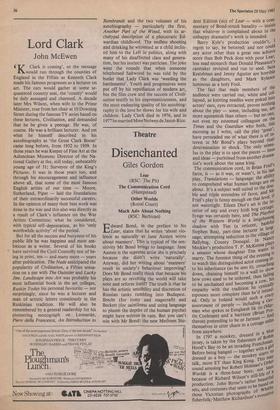Lord Clark
John McEwen
T2- Clark is coming', so the message Ilwould run through the counties of England in the Fifties as Kenneth Clark made his famous progresses as a lecturer on art. The cars would gather at some se- questered country seat, the 'county' would be duly assuaged and charmed. A decade later Mrs Wilson, when wife to the Prime Minister, rose from her chair at 10 Downing Street during the famous TV series based on these lectures, Civilisation, and demanded that he be given a peerage. He was, of course. He was a brilliant lecturer. And yet what he himself described in his autobiography as 'the Great Clark Boom' came long before, from 1932 to 1939. In those years he was Keeper of Fine Art at the Ashmolean Museum; Director of the Na- tional Gallery at the, still today, unbeatably young age of 31; Surveyor of the King's Pictures. It was in those years too, and through his encouragement and influence above all, that some of the most famous English artists of our time — Moore, Sutherland, Piper — laid the foundations of their extraordinarily successful careers. In the opinion of many their best work was done in the war and this also was directly as a result of Clark's influence on the War Artists Committee; what he considered, with typical self- deprecation, as his 'only worthwhile activity' of the period.
But for all the success and busyness of his public life he was happiest and most am- bitious as a writer. Several of his books have survived the Cyril Connolly test of be-
ing in print, ten — and many more — years after publication. The Nude anticipated the popularity of Civilisation, a Fifties sensa- tion on a par with The Outsider and Lucky Jim. Landscape into Art was probably his
most influential book in the art colleges,
Ruskin Today his personal favourite — not surprisingly, since he was a lecturer and
man of artistic letters consciously in the Ruskinian tradition. He will also be remembered by a general readership for his
pioneering monograph on Leonardo, Piero della Francesca, An Introduction to Rembrandt and the two volumes of his autobiography — particularly the first, Another Part of the Wood, with its ar- chetypal description of a plutocratic Ed- wardian childhood. The endless shooting and drinking he witnessed as a child inclin- ed him to the Left in politics, along with many of his disaffected class and genera- tion, but his instinct was patrician. The joke went the rounds that when someone telephoned Saltwood he was told by the butler that Lady Clark was 'weeding the battlements'. Youth and progressives were put off by his repudiation of modern art, but the film crew and the success of Civili- sation testify to his unpretentiousness, and the most endearing quality of his autobiog- raphy is the love he shows for his wife and children. Lady Clark died in 1976, and in 1977 he married Mme Nolwen de Janze-Rice.














































 Previous page
Previous page